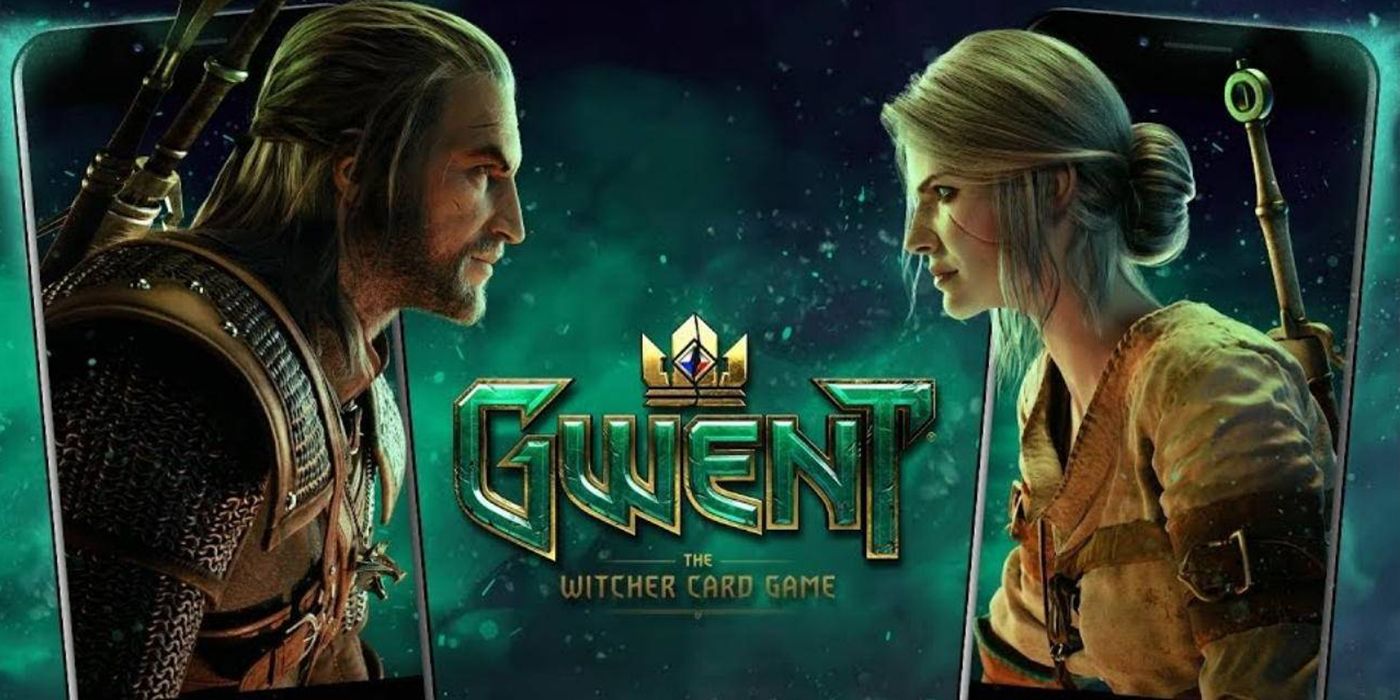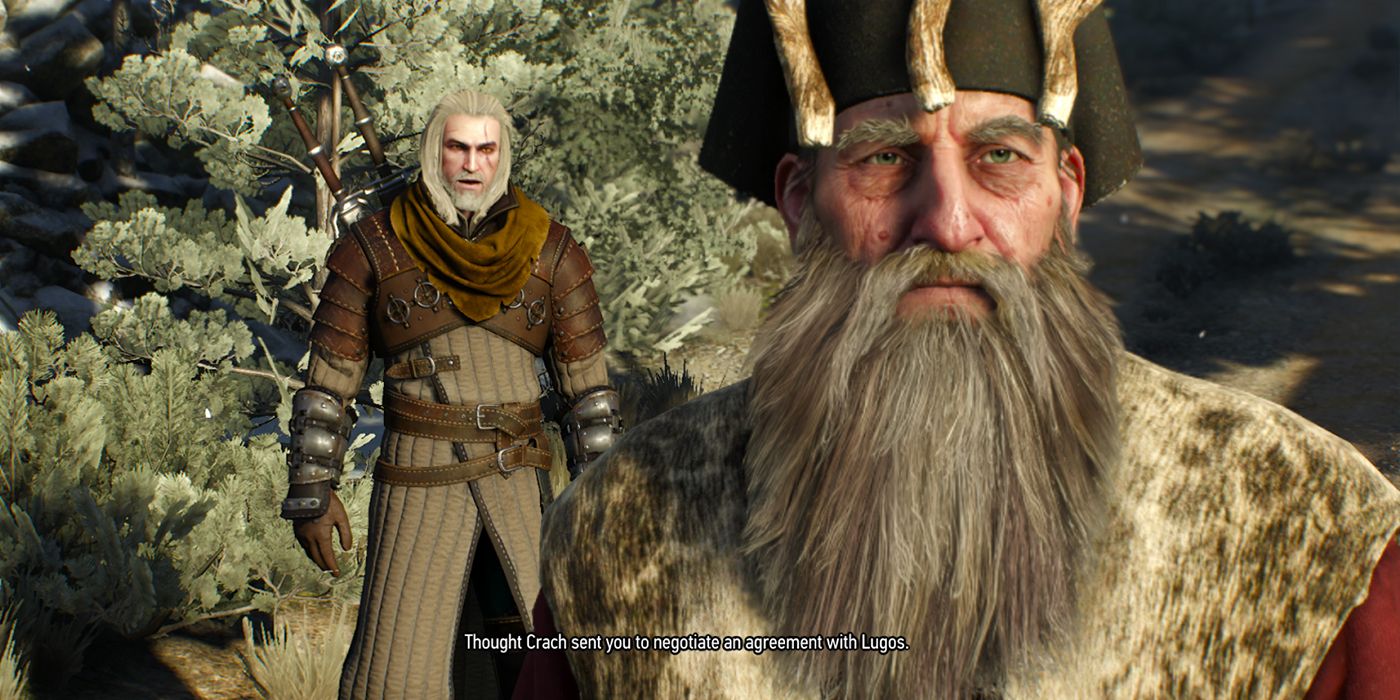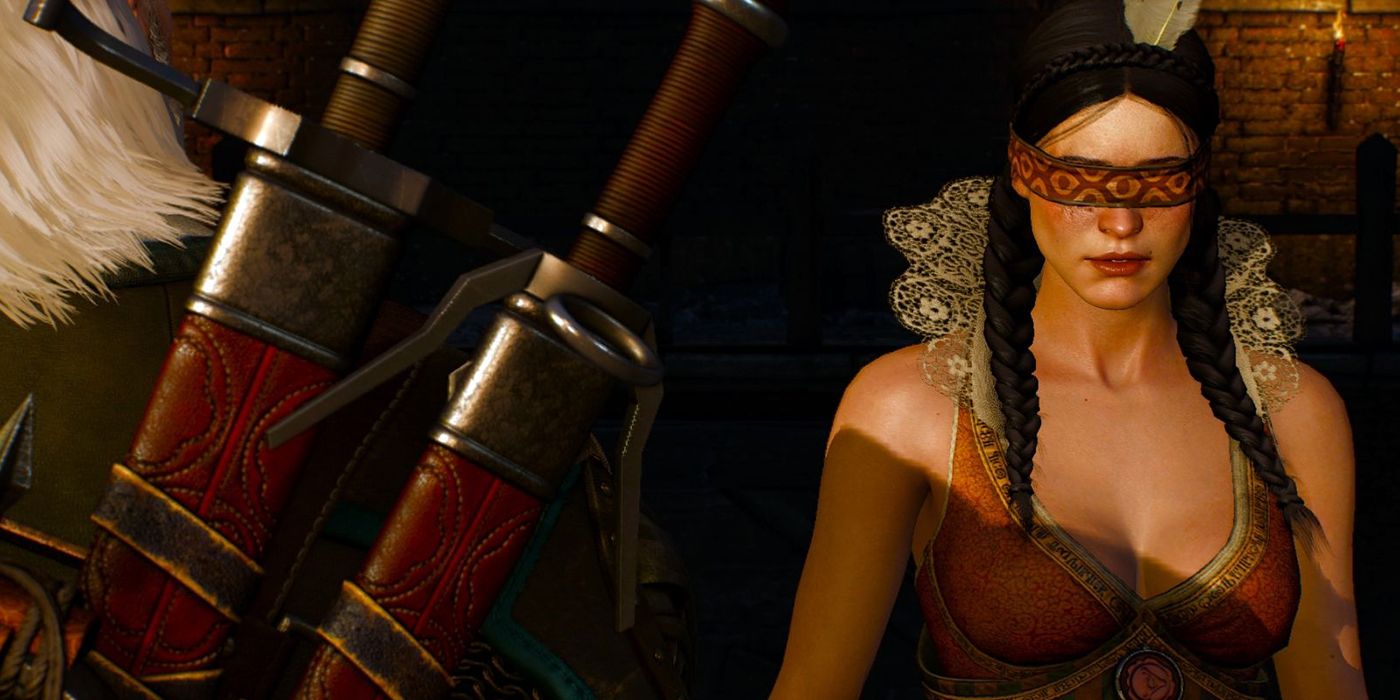Playing Gwent in The Witcher 3 is ridiculously addictive, but there's one drawback for people who haven't read the books or played the earlier games: a lot of famous characters, especially those featured on hero cards, aren't really explained at all. Arguably, it's just a bit more fun to trounce that one innkeeper at Gwent when familiar with the character card that cements the win.
So for those players who love using their Northern Realms deck but have no idea who Esterad Thyssen actually is, here's a handy guide to each and every one of the characters featured on Gwent hero cards (minus a couple of non-specific monsters and Geralt of Rivia himself). From Saesenthessis to Tibor Eggebracht, there are some big names from all across the Witcher franchise to cover.
Cerys an Craite
Fortunately, players have the pleasure of meeting Cerys (or, depending on choices during the game, Queen Cerys) in The Witcher 3's main campaign. Cerys an Craite is the "Sparrowhawk" of Skellige, daughter of a powerful Jarl and a great warrior in her own right. She's stubborn and confident, but also level-headed and clever; all qualities that make her an excellent leader.
Cerys's Gwent card is a strong 10 and can summon shield maiden cards to the board when played.
Cirilla Fiona Elen Riannon
Does Ciri need too much explanation? She's got such a rich history in the Witcher universe, and she's really the secret main character of The Witcher 3. As Geralt and Yennefer's adoptive daughter, Ciri has powerful magic and combat skills at her disposal, as reflected in her Gwent card: Ciri and Geralt's both boast a power rating of 15, the strongest cards in the game.
Eithne
Eithne the Silver-Eyed is the queen of the dryads and the ruler of Brokilon; although she's present in many of the Witcher novels, she has exactly zero appearances in any of the three Witcher RPGs from CD Projekt Red.
In the books, Eithne is known for two things: her remarkable wisdom, and her unbending hatred of humans. The only people dryads regularly allow to set foot in Brokilon are elves (hence Eithne's presence in the Scoia'tael deck), and they're a mostly reclusive people, drawing strength from the primal energy of the forest around them. Brokilon itself is just as magical as the dryads, and one tale says that dryads can see the future in the waters of the forest, hence how difficult is to surprise them.
In her Gwent card, Eithne's skills as a master archer make her part of the 'ranged' card category.
Ermion
Those who watched the recent Netflix Witcher show might be surprised to know that the character Mousesack has another name: Ermion. Similarly, those who have played The Witcher 3 may not know that these two characters are actually one and the same.
Ermion is a powerful druid, formerly an advisor to Queen Calanthe of Cintra before her demise and caretaker of Ciri; at the time of The Witcher 3, he's the advisor and friend of Skellige's king, Bran Tuirseach. Ermion and Geralt are also longtime friends since childhood, and when both later ended up at a duplicitous witcher tournament actually designed to eradicate the school of the wolf witchers, Ermion helped Geralt to escape with his life. He was also present during the fall of Cintra, though he managed to escape it.
The Witcher 3 hints at Ermion's long history with Geralt and Ciri, but it's never fully explained. Suffice to say, he's been around since the very beginning of the Witcher stories.
Esterad Thyssen
Esterad Thyssen was the king of Kovir and Poviss during the second war with Nilfgaard, and present in some way through many of the Witcher novels. Unfortunately, Esterad is killed before the events of the games can begin, though he's mentioned in The Witcher 2; when ambushed by assassins outside of his palace, Esterad chose to stay and fight for his wife's sake even though he could have saved himself by waiting for the guards. In the end, Queen Zuleyka survived without a scratch, but Esterad was mortally wounded.
Hjalmar an Craite
Hjalmar is the hot-headed brother of Cerys, son of Jarl Crach an Craite. He's another contender for the throne of Skellige in The Witcher 3 (and it's Geralt's decision who takes the crown) so players don't have to worry about not knowing his name when it pops up in Gwent. He falls under the ranged category, with a power level of 10 just like his sister.
Imlerith
Imlerith shouldn't be too hard for Witcher 3 players to figure out either, since that game is his only mention or appearance in the entirety of the available Witcher media out there. Sure, the Wild Hunt comes up in other places, but Imlerith himself is a CD Projekt Red addition who serves as one of the main bosses of The Witcher 3 as one of Eredin's generals. He's a close-quarters combatant with a score of 10 in Gwent, playing for the monster deck.
Iorveth
Iorveth has limited appearances in one of the Witcher books, and his only physical in-game appearance is in The Witcher 2. Thus, anyone who skipped to Wild Hunt may not know him: Iorveth is a factor in one of The Witcher 2's biggest choices, and siding with Iorveth radically changes the players' experience compared to a playthrough siding with Vernon Roche instead.
Iorveth himself is an Aen Seidhe elf and the commander of a Scoia'tael commando unit skilled in guerilla warfare; Iorveth's soldiers were fiercely loyal to him and he was a cunning commander, though outside of his unit, Iorveth was seen as a terrorist.
Isengrim Faoiltiarna
As it turns out, Geralt isn't the only "wolf" in The Witcher universe. Isengrim Faoiltiarna is only mentioned in the CD Projekt Red games, but he appears in a couple of Witcher novels as one of the most experienced members of the Scoia'tael, earning himself a moniker: the Iron Wolf.
When the second Nilfgaard ended, Isengrim and 31 other elven commanders who fought with Nilfgaard were surrendered to the Northern Realms for execution as part of the truce, but Isengrim himself managed to escape alone. By the time The Witcher 3 rolls around, Isengrim's whereabouts are unknown, though his reputation remains.
John Natalis
On the flip-side, John Natalis was a commander for Temeria, one of the Northern Realms. He shows up in one of the Witcher books and The Witcher 2, even temporarily serving as the regent of Temeria after King Foltest's assassination. According to Vernon Roche, sometime in between The Witcher 2 and 3, Natalis's forces were thoroughly defeated when Temeria fell, so his current whereabouts (or whether he's alive) are unknown.
Letho of Gulet
Letho of Gulet, the Kingslayer, is a witcher from the School of the Viper. He's another games-only character, having been introduced as the assassin of King Foltest in The Witcher 2 (for which Geralt is framed) and potentially as an ally in an optional The Witcher 3 quest if Geralt decides to spare his life. As for why Letho agreed to kill kings instead of monsters, that answer lies with the offer Emperor Emhyr var Emries made him: in exchange for sowing chaos in the north, the emperor promised to rebuild Letho's witcher school--a promise that he never made good on.
Menno Coehoorn
Menno Coehoorn was a field marshal in the Nilfgaardian army and confidant of Emhyr var Emries, enough so that he was granted temporary governorship over Cintra. While not in the games, Coehoorn is present throughout several books as a dedicated servant of the Nilfgaardian Empire, though he eventually met his end. Confronted with the remnants of Zoltan Chevay's company, he was shot with three crossbow bolts and fell into the Chotla River, though his body was never found.
Morvran Voorhis
When Imperator Morvran Voorhis comes to interrogate Geralt at the beginning of The Witcher 3, that's not actually his first moments as part of the franchise: he's also in a couple of the books, always portrayed as a true Nilfgaardian and relative to Emperor Emhyr. Knowing that, his presence in Wild Hunt isn't surprising since Emhyr himself is a villain of sorts in the game. During the Third Northern War, he was Nilfgaard's most important general. As a pure-blooded aristocrat with clear ties to Emhyr, Morvran's claim to the throne of Nilfgaard was always solid, and it's been confirmed that he ascended to the throne around the end of the 13th century.
Mysterious Elf / Avallac'h
While his card is presented as "Mysterious Elf," it's presumably so that Avallac'h's presence in the game won't be discovered until the big unveiling moment when Uma's curse is lifted. Regardless, the mysterious elf is most definitely Avallac'h. Before his role in The Witcher 3 began, Geralt had met the elven sage years earlier, and found him to be unnervingly interested in the Elder Blood, and thus in Ciri. Though Geralt never trusted Avallac'h's motivations where Ciri was concerned, he became her tutor over the years, attempting to teach her how to control her powers. Then, when the Wild Hunt began its search, he protected Ciri from them.
Philippa Eilhart
Philippa Eilhart is a cunning and ambitious sorceress, formerly an advisor to King Vizimir of Redania until his death (for which she's probably responsible), who led a coup on the Brotherhood of Sorcerers to try and weed out traitors loyal to Nilfgaard. Upon destroying the Brotherhood, Philippa became the founder of the Lodge of Sorceresses, and thus its leader. By The Witcher 3, Radovid of Redania has blinded Philippa by ordering her eyes removed, and she's searching for a way to restore them--along with her position of power in the world.
Saesenthessis
Otherwise known by the people of the Continent as Saskia the Dragonslayer, Saesenthessis was a dragon with the power to take on a human form, and in doing so she became a war hero. In the books, Saesenthessis' birth is only possible because of Geralt's intervention during the famous Hunt for the Dragon; he helped Saesenthessis' father, a golden dragon who called himself Borch in human form, stop hunters from killing the hatchling dragon as they killed her mother. Those who watched the Netflix show will remember this moment too, from episode 6.
In The Witcher 2, Saskia ends up being manipulated by the sorceresses Philippa Eilhart and Sile de Tansarville, which Geralt can choose to put a stop to. If successful, Saskia survives the Third War and escapes Vergen, hale and whole.
Tibor Eggebracht
Tibor Eggebracht was a Nilfgaardian colonel of great esteem, who commanded the Alba armored division before Morvran Voorhis took over. However, Tibor only makes an appearance in one Witcher book, during which his cavalry division was wiped out during the Battle of Brenna and he himself was killed.
Triss Merigold
Triss Merigold, the Fourteenth of the Hill, is one of the most powerful sorceresses on the Continent. Friend to both Geralt and Yennefer and a big sister-figure to Ciri, Triss obviously plays an important role throughout all of the Witcher books and games. For Wild Hunt's purposes, Triss had previously been Geralt's primary love interest, though now can romance either her or Yennefer. Regardless of romantic entanglements, Triss remains a loyal friend to all and joins the fight against the Wild Hunt.
Vernon Roche
Vernon Roche makes his debut in the games, beginning with The Witcher 2. He's the commander of the Blue Stripes, an elite Temerian force, and his is the other major path in addition to Iorveth's that determines the course of the game. Whether or not his path is taken, Roche and Geralt meet again as friends in The Witcher 3, though Roche is now displaced as a guerilla fighter resisting Nilfgaardian rule.
Yennefer of Vengerberg
Finally, there's Yennefer of Vengerberg. Arguably Geralt's true love and mother to Ciri, Yennefer's history is nearly as long and complex as that of the witcher, and she's easily another of the Continent's most powerful sorceresses. Though Yennefer doesn't appear in the first two games, her absence is still mentioned (and felt). Wild Hunt may be Yennefer's first in-game appearance, but she's been tightly bound to the fates of Geralt and Ciri since the beginning.
When considering The Witcher in all of its novels and video games, catching up and learning about that world may seem like a dizzying task. Nonetheless, it's entirely possible to enjoy Wild Hunt on its own, provided just a bit of background information for maximum effect.
The Witcher 3 is out now for PC, PS4, and Xbox One.



